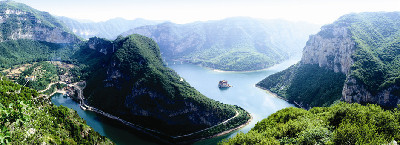 |
| Nine Maidens Lake natural reserve area |
The city of Jincheng is in the southeastern part of Shanxi province, adjacent to Taihang Mountain to the east, Central China to the south, the Huanghe River to the west, and Yanshan Mountain to the north, and covers a 9,490-square-kilometer area. It has 188,920 hectares of cultivated land and a population was 2,197,100 (2004 census) with the non-agricultural population amounting to 466,500. It has 22 ethnic groups, with the Hui being the largest.
Jincheng is an important transportation hub for Shanxi and Central China and is easily accessible, with the Taijiao Railway line (from Taiyuan, Shanxi to Jiaozuo, Henan province) and the Houyue line (Houma, Shanxi to Yueshan, Henan) passing through the city. The Jinjiao Freeway (from Jincheng to Jiaozuo), Changjin freeway (from Changzhi to Jincheng, Shanxi), Provincial Rd 207, and other roads convene for a convenient transportation network.
The city also has a long history with a wealth of culture and heritage and is a cradle of Chinese civilization. The first inhabitants date back to 20,000 years ago during the Upper Paleolithic.
Jincheng has great mineral resources, including coal, gas, ferromanganese iron, alumina, copper, zinc, gold, silver, marble and crystal, with considerable coal and iron ore reserves. Its coal area covers 5,350 square kilometers, or 56.4 percent of the city’s total area and total coal reserve are 80.8 billion tons, with proven reserve of 27.1 tons. Anthracite coal, the main type of coal in Jincheng, accounts for more than 25 percent of the country’s total and 50 percent of Shanxi's and is good quality, with little sulfur content and high heat. Its carbon blocks are smokeless and tasteless and provide good light, hence the name "white coal", "fragrant coal", or "orchid charcoal".
It was also chosen as fireplace coal for the British royal family. It is currently sold to 20 provinces, cities and autonomous regions across the country and to other countries and regions, including Britain, Japan, Korea, Southeast Asia and Western Europe. The city has a large coal bed methane (CBM) field, discovered in nearby Qinshui county in 2001, with proven reserves of 100 billion cubic meters. It was also designated as a national raw coal base for the fertilizer and chemical industries, back in 1984, and was chosen as a base for high concentration nitrogenous fertilizer made from high quality coal as part of the 9th Five-year Plan for National Economic and Social Development and the Outline of Long-range Objectives Through 2010 by the National People's Congress, in 1996.
Jincheng has considerable forest resources as well and a forested area of 253,666 hectares and has the only primeval forest of Shanxi, in Qinshui county, covering more than 730 hectares. There is also an animal husbandry base in Shanxi with 254,700 hectares of natural pasture land and North China’s largest demonstration pasture.
It is famous for its silk as well and North China's largest silk base, with its silk production accounting for 80 percent of the province’s total.
Jincheng has a moderate climate with plenty of rainfall and is suitable for growing various types of animals and plants, so it is called "Shanxi's biological treasure". It has two national nature reserves near the city of Yangcheng and in Qinshui county and is a natural habitat for edible tree fungus and mushrooms. It is also a national production area for hawthorns and has a provincial health food base producing health foods made from yellow pears, hawthorns, and medicinal herbs.
The city is also rich in water resource, with 2.15 billion cubic meters and a per capita amount of 872 cubic metes, well above the provincial average and that of adjacent provinces.